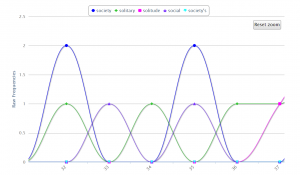In efforts to incorporate digital literacies and technologies into the classroom, I began brainstorming a list of classroom applications. Since much of our discussion focuses on how to use these tools in meaningful ways, I thought we could all participate in offering our own practical suggestions. I am not sure where to go with this in a Lit course, as we have discussed the various ways that these tools were utilized in our readings from last week, but I’m thinking we should be focusing on extensions of those activities–the “so what?”
Dear community of scholars, please add on to this meager list of mine!
-
Voyant
–Composition Classes–
Application: Writer’s Notebook
Pedagogical Value: Allows for inclusion of multi-genre applications, mapping of word frequencies, which may lead to general themes of writing, can be used for brainstorming entries, etc.
Application: Revision Processes
Pedagogical Value: Maps word frequencies, could help with word choice, repetitive phrases, parallelism, etc.
–L & C Classes–
Thinking of ways that Voyant can be used in the context of the classroom, I’d like to add this to our running list from class discussion yesterday (3/3) with Dr. Sherwood’s Thoreau Voyant:
Application:Index for Comparison/Contrast or Mapping of Rhetoric.
Pedagogical Value:
With a work like Walden, Thoreau makes an argument for his anti-social lifestyle. Based on the mapping, there is a wave intersection between “solitary” and “social” when the diagram is enlarged between 31 and 35.
Looking at the diagram, it looks as though these two opposing terms represent a dialectic: solitary (thesis) and social (antithesis). The dialectic takes this map: thesis–>antithesis–>thesis–>antithesis–>thesis, which then conclusively rises above the rhetoric (frequency increases) and is correlated with a rise in the word frequency of “solitude.”
The application of compare/contrast already provides a visual Venn diagram with the purple and green lines, which can help students in locating the trends and points of intersection between these terms. Additionally, this visualization can offer to students a visualization of the rhetoric and dialectic mentioned above, which can be used in a lit or comp class.
*Screen shot of magnification of this frequency section borrowed from Dr. Sherwood’s blog: *
This is a little mechanistic, but I was thinking about something I read about a few years ago — a Pearson service that “graded” entrance essays by computer. Now, how was this possible? Well, it turned out that there were “markers” of good essays (things like word count, grammatical complexity, number of sentences per paragraph, use of multi-syllabic words, correct spelling, etc.) that correlate very well with good writing. Now, this meant that someone who wanted to do so could “fake it” — writing 500 words of complete nonsense in ways that simulated without actually producing coherent writing. ….
So, what does this have to do with Voyant? I wonder about having students think about their own writing in these terms. Have them visualize “bad” and “good” essays. Or for that matter, have them visualize rough drafts and final drafts. Are they different? In my composition class, I put a very strong emphasis on revision (with the conviction that it is very hard for students to change their writing and not improve it, so that I incentivize change.) Voyant would possibly give students a picture of what dramatic revision looks like. (There might be other tools more suited to this.)
I really like the idea of visualizing “good” and “bad” essays using Voyant. Something like the visualization of the various steps toward a dramatic revision can also provide data for a student’s progress in writing, as well. When I have monthly meetings for my FYSP (First Year Success Program) students, I have to provide an update of each student’s progress. It may take a little trial-and-error, but I think including something like this revision process mapping and visualizing a student’s progress over the entire semester with various types of writing could be a valuable assessment and record for that progress vs. copies of essays in a file that don’t hold much value without reading them. It’s a two for the price of one deal, if used in this context.